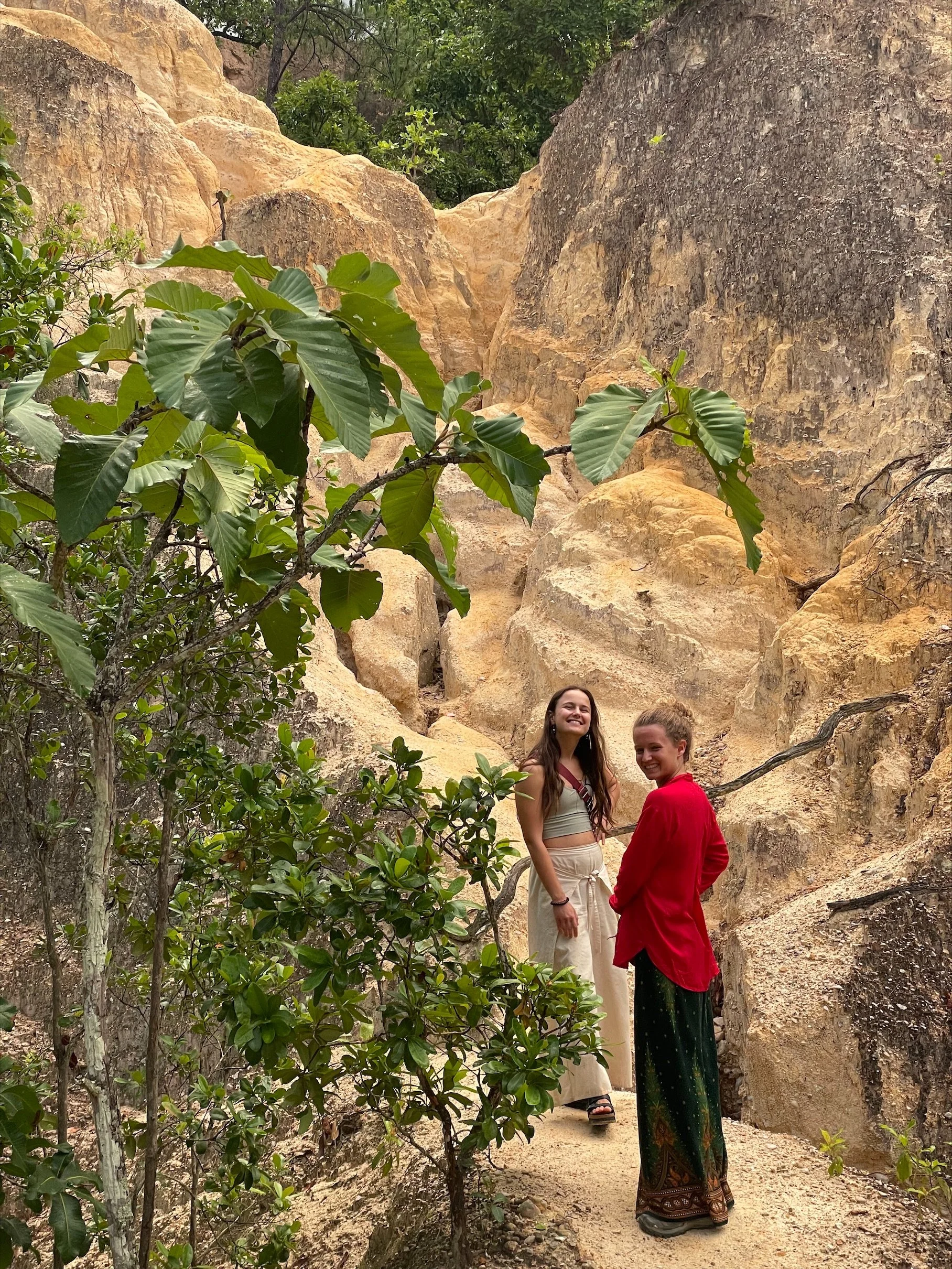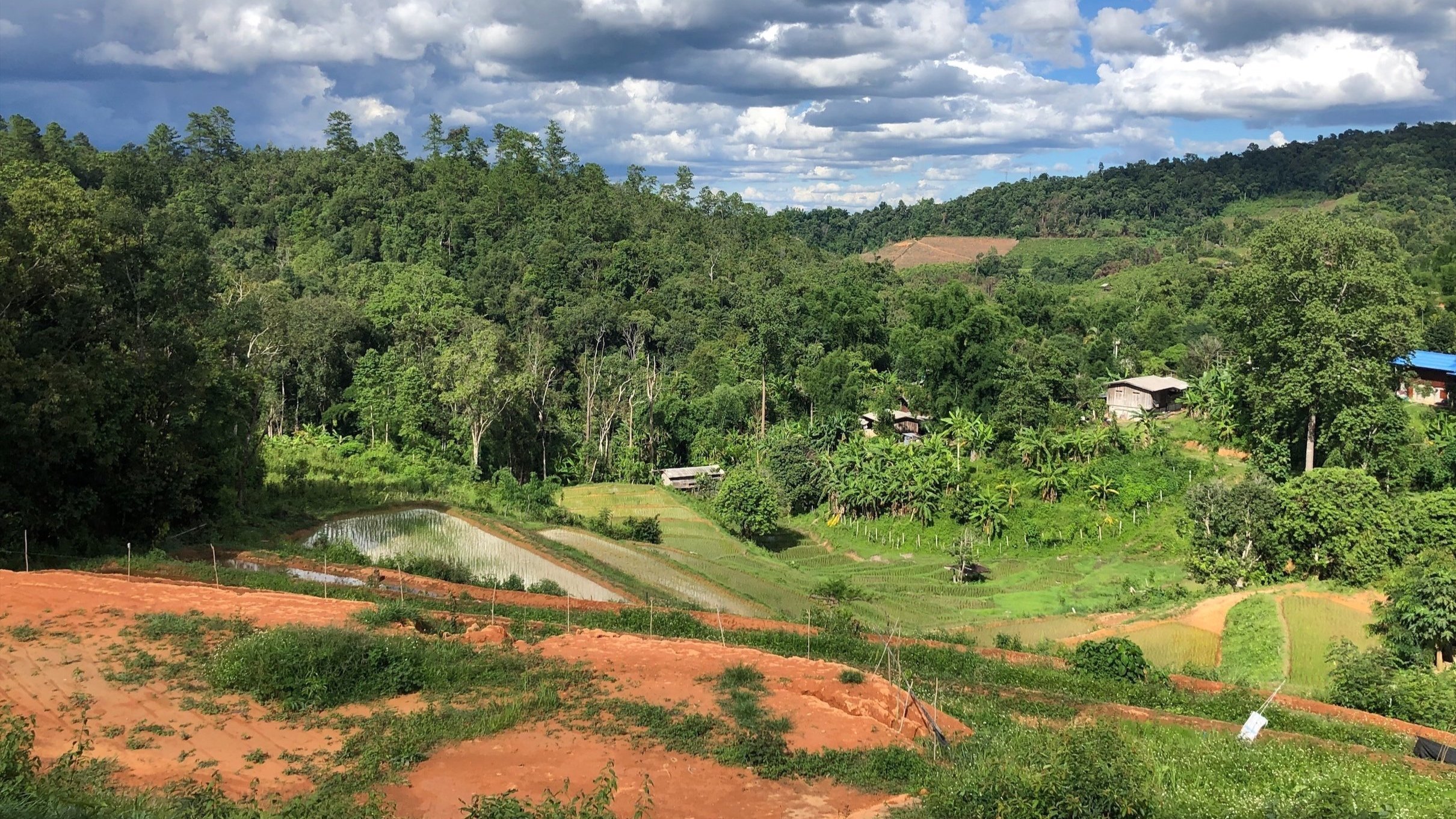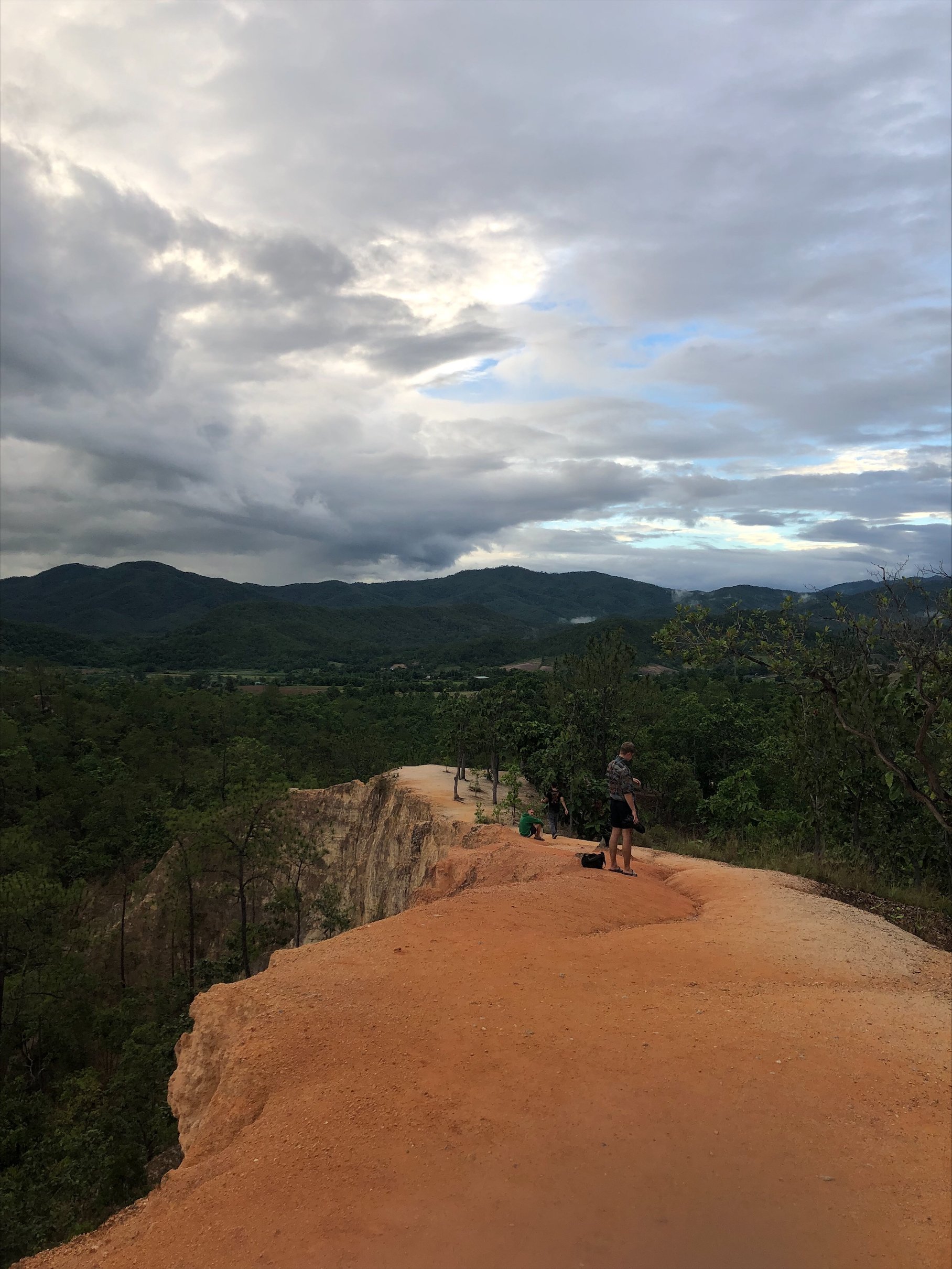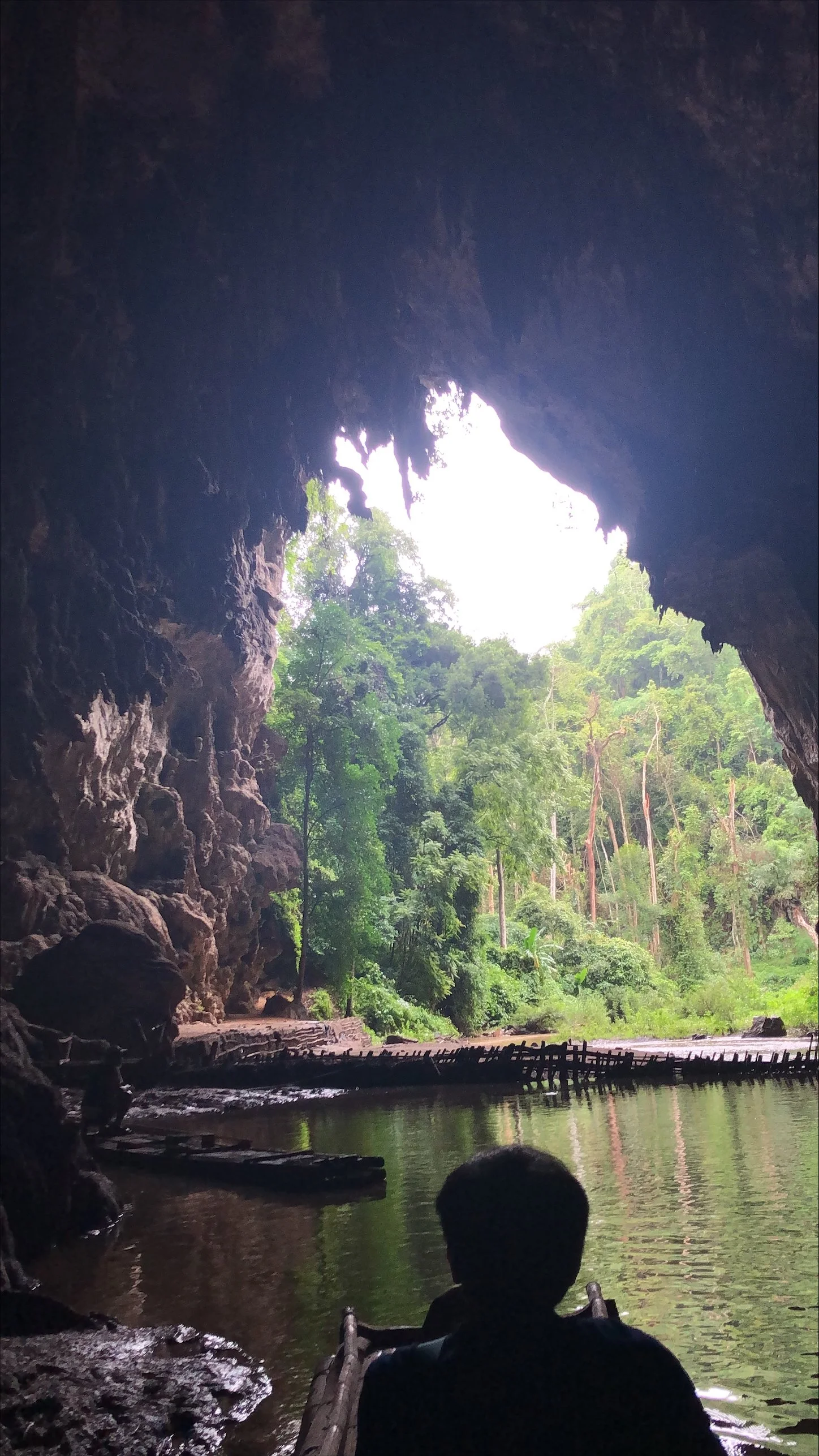Unveiling one of Thailand’s most gentrified towns: Pai. An in-detail recollection of the town’s community life and its natural beauty.
BY SARA DELGADO GARCIA
When I think about Pai I remember being on the back of my friend Rebekka’s bike whilst she was singing the Spanish song ‘Como quieres que te quiera’. It is raining greatly as we come back from the Mo Pang waterfalls. Riding through the small roads amongst the Thai forest, warm weather and absolute silence. Can we drive forever? Then I also look back to the other side of that town. My friends had suggested we go to a bar called Spirit for our last night. Entering that place was like going into another universe, with a long alley full of psychedelic drawings projected and a ceiling of fairy lights and random objects hanging. Sitting barefoot on the floor, above our heads, an open sky. Dim lights, low tables, the smell of incense. We’re on the mezzanine, away from all the chaos of the bottom floor and in the middle of the room a cascade of lights illuminates the artists performing and the paintings on the walls.
After two months of travelling and writing around Thailand and Laos, I surprised myself by choosing this town as the subject for my first article. Anyone who has been to the area can’t help but feel somewhat puzzled as well. Next to the astonishing waterfalls of Luang Prabang, the endless night markets of Chiang Mai and the breathtaking temples of Chiang Rai, there doesn’t seem to be much to say about Pai. People described it as ‘the backpacker’s paradise’, a town where all the travellers of Southeast Asia meet. I had been advised to avoid the town itself but not miss its surroundings, others had insisted on how intrinsic the streets of Pai would be to my journey. Not sure of whom to believe, I tried doing both: explore its natural beauty and immerse myself in that secluded universe of travellers who were not ready to leave.
A Western-oriented gentrified town
Something I noticed within the first couple of hours is how invasive the Western culture has been with this place. The menus in every restaurant are in English rather than Thai, it is easier to find a pizza than a good roti and the most crowded place at night is the Jazz House, where nine songs out of ten are a pop-rock hit. Yet it’s there where some of my best nights took place.
I would also recommend - as little immersive as that is - the Karaoke bar on Main Street, for it is the perfect example of the encounter of nationalities that characterises Pai. I spent a few nights there and learnt more songs in Hebrew than in Thai. Still, I got a chance to meet some locals who were eager to socialise with farangs (that’s what Westerns were called here and in Laos).
A place which helped me understand the Pai community was The House of Tea. In that tea shop, you could run into people sketching, and meditating, some in whispered conversations and others with a guitar and a tambourine bringing some music to the atmosphere. Shoes were not allowed inside and people were sitting on the floor. We spent hours there without noticing the flow of time, and the people I got the chance to meet there only added to the experience. Dill was an Australian who was extremely talented when it came to improvising lyrics, Janis, from Germany had been trained by a Rekki master to unload your negative energy, Rebekka was the best at drawing people in three minutes.
My hostel UP2U, was slightly further from the town center and felt like a tree house. With almost everything built with wood and not many closed spaces, it was far from noise and had panoramic views of the mountains. I can’t help but mention the showers: imagine showering on the outside, overlooking an immense landscape and spying a Buddha statue you’ll no doubt visit.
But as amazing as all of it was, I couldn’t help missing a certain sense of authenticity. It seemed as if all these things were created for the tourists or even the backpackers who chose to stay there for weeks. This is the reason why exploring outside of town sometimes felt like a breath of fresh air.
Natural Wonders and where a scooter can take you.
One of my best choices was to rent a scooter to explore the surroundings. We spent an entire morning sliding down the rocks of the Mo Pang waterfall. By chance after that trip, we decided to go visit the bamboo bridge of Pai, one of my main recommendations. My friend and I were lucky enough to go late in the afternoon; when everyone had left, it was a wonder to cruise the rice crops following the bamboo road. Because it was so quiet, we were able to sit in the middle of the bridge with our feet hanging, admiring the landscape of this valley amongst the mountains. Following the road, we found a small forest, and at the end of the way, a modest temple carved in dark wood.
Pai’s Grand Canyon is another spectacle of the town’s surrounding nature that you can’t miss if you have a bike. A twenty-minute drive from town, we made it there for the sunset, however, the cloudy sky didn’t allow much of a colour burst. Nonetheless, the grey sky contrasted amazingly with the distant dark blue mountains and the red-soil crest drew lines above the dark green thicket. There was a small walk-through forest leading to the canyon. Once you got there, several paths, ramified roads of soil, allowed you to make your way to different viewpoints. It was very fun to climb around those small cliffs, trying to reach the highest point, perhaps more for the sake of climbing than the view, as impressive as this one was.
The Lod caves were probably one of the town’s most touristic attractions. There was a very solid infrastructure built within and countless wood bridges and ladders to navigate in the darkness, a quite fun part of the tour if you ask me. Bigger than any I had visited, I loved wandering around the subterranean lake on a small canoe and with only a torch. Or giving meaning to the different shapes water had carved in the stone for thousands of years and feeding the huge fish on the river that crossed it. And even if you’re not that into caves, I’d recommend them just for the bike trip. Driving across one village after another, stopping in every viewpoint to contemplate a sea of clouds in which we kept floating, the smell of rain and the background music my friend was playing… There are not many things I could compare to the feeling I had during those couple of hours on the road.
After a week of trying to unveil the two sides of Pai, going back to people’s parted advice on the place, my only conclusion would be they were both wrong. I believe the community waiting for you in Pai is an essential part of the visit, as fabricated as it may sometimes feel. Maybe in an ideal world, this town would’ve remained untouched by gentrification, but the best we can do is enjoy some of the good sides: an international community, an encounter between cultures and perspectives, a bubble where you can forget about the world without feeling that far away from home. Still, it would be a mistake to limit ourselves to that: with less than 5 pounds a day and a bit of practice, the northwest of Thailand can be within reach. The natural beauty of the place is undeniable, and I got to witness sights that are now etched in my memory. So, I guess my only advice is: if you manage to get there, try to see, do, and explore as much as you can. Even months after, as I write these words from a coffee shop in our cold and lovely Scottish town, I can’t help counting the days before I can be out there again, discovering a world I wish to write about.




